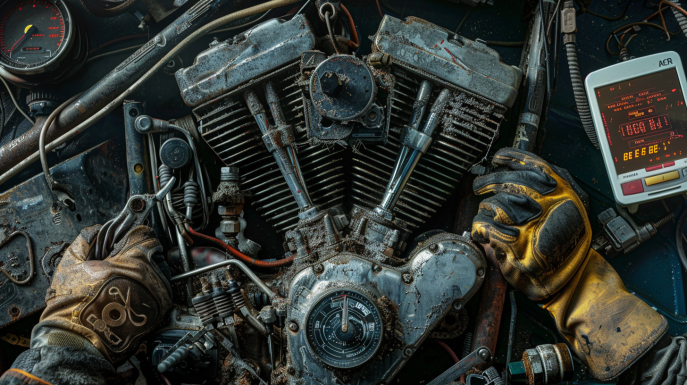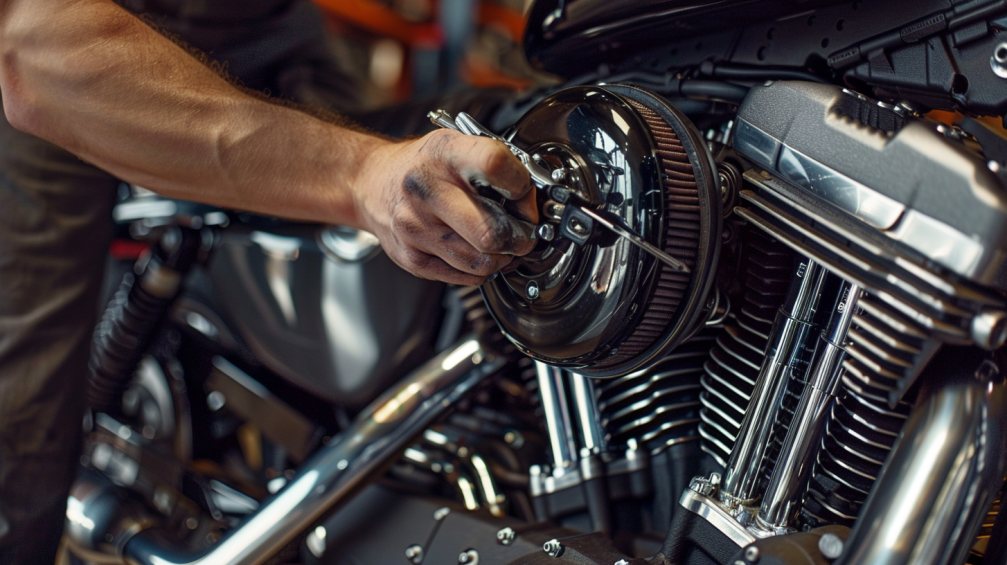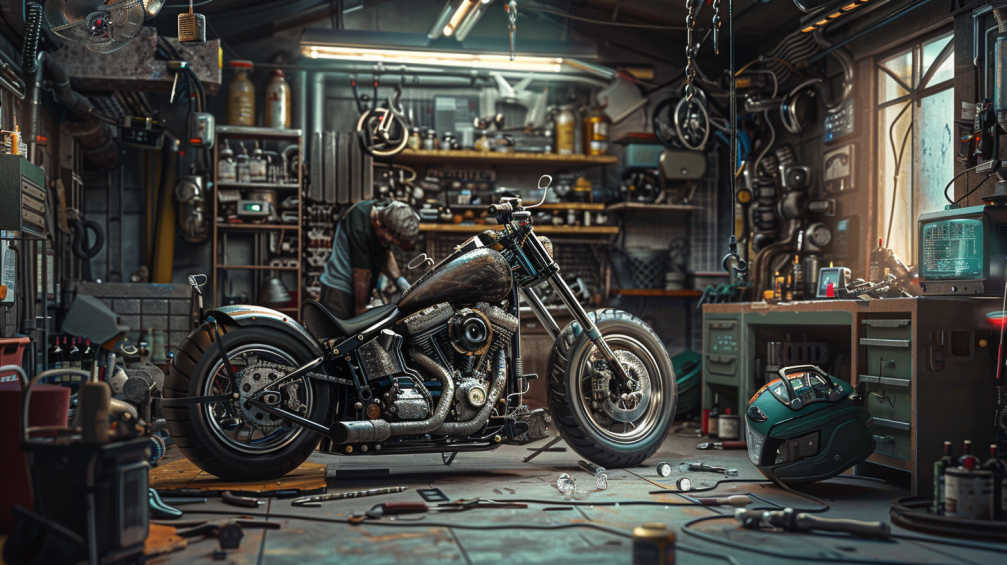To address Harley automatic compression release (ACR) problems, guarantee proper installation and maintain solid, corrosion-free connections. Use a multimeter to check voltage during start-up and closely follow installation instructions. Regularly inspect for leaks, blockages, and faulty wiring. Test the solenoid function bi-annually and clean valves annually. If issues persist, seek help from an authorized dealer or experienced mechanic to diagnose and fix complex problems. Adhering to a maintenance schedule and replacing components every 20,000-30,000 miles will help you achieve smooth engine starts and prevent further complications. Find out more ways to maintain peak performance next.
Key Takeaways
- Ensure proper installation and secure electrical connections to prevent ACR malfunctions.
- Regularly inspect and maintain ACR components to avoid leaks and compression loss.
- Verify the ACR solenoid function and replace it if necessary to ensure reliable starts.
- Consult a Harley Davidson authorized dealer or experienced mechanic for complex ACR issues.
- Consider manual compression releases for more control and smoother engine starts.
Understanding the ACR System

Understanding the Automatic Compression Release (ACR) system on your Harley Davidson is essential for ensuring easy engine starts and reducing wear on the starter motor. This system is a game-changer, especially for high-compression engines, making your bike’s roaring start smoother and more efficient. By reducing compression pressure during start-up, the ACR system prevents the engine from straining and safeguards vital components from excessive stress.
Embracing the freedom your Harley represents means understanding its inner workings, and the ACR system is a key player in maintaining your bike’s health. The beauty of the ACR system lies in its automation—no manual intervention is required. It operates seamlessly, kicking in during start-up and deactivating once the engine roars to life. This automatic compression release mechanism is controlled by the Engine Control Module (ECM) in factory setups, ensuring peak performance and longevity.
For those who thrive on knowledge and independence, plenty of online resources can deepen your understanding of the ACR system. Knowing how it functions and recognizing its value will keep your Harley running strong, ready to take you wherever the open road calls.
Common ACR Issues
While the ACR system is a marvel in ensuring smooth engine starts, it can face several common issues that bikers should be aware of. One of the most prevalent problems lies in the installation of compression releases. If not done correctly, installation issues can cause the ACR to malfunction, affecting the bike’s overall performance. Incorrect wiring or faulty connections to the starter solenoid can disrupt the ACR operation, leading to unreliable starts.
Another common issue is the ACR solenoid failure. Over time, these components can wear out, leading to a failure in the automatic compression release mechanism. This can make starting your bike more challenging, particularly in extreme weather conditions or with heavily modified engines.
Additionally, leaks within the ACR system can also pose a significant problem. These leaks can cause a loss of compression, resulting in poor engine performance and potential damage if left unchecked.
Regular maintenance is important to prevent these problems. Ensure all parts are correctly installed and routinely inspect for wear and tear. By staying vigilant, you can enjoy the freedom of the open road without the hassle of ACR issues holding you back.
Symptoms of ACR Problems
Experiencing difficulty starting your Harley, especially in hot or cold weather, can be a telltale sign of ACR problems. When the Automatic Compression Release (ACR) system malfunctions, you might notice your bike struggles to turn over or takes longer to start. This is because the ACR helps reduce compression during engine startup, making it easier on your starter motor.
If your ACR isn’t working correctly, you’ll feel that extra strain. Starting difficulties are more pronounced in extreme temperatures, where your bike’s engine needs more assistance. You might also experience kickback – a sudden jolt when the engine attempts to start, which not only feels uncomfortable but can damage your starter motor over time.
A malfunctioning ACR can make your engine modifications, like an increased compression ratio, even more problematic. High compression engines require more power to start, and without a properly functioning ACR, it’s a tougher battle. You may find yourself needing to upgrade your starter motor just to manage these starting issues.
In short, if starting your Harley feels like a chore, it’s a clear indicator that your ACR system needs attention. Don’t let these symptoms go unchecked, as they can lead to greater engine strain and potential damage.
Causes of ACR Failures

Improper installation is a common cause of ACR failures in Harley models like the Road King and Street Glide. When you install the ACR system incorrectly, it can lead to a cascade of issues. Ensuring each component is securely and accurately placed is important for your Glide’s performance. Misalignment or loose connections often cause the ACR to malfunction, impacting your bike’s ability to start smoothly.
Electrical faults are another frequent culprit. Issues with power sources and wiring can disrupt the ACR’s operation, leaving you with a bike that won’t start as effortlessly as it should. Regular checks on your wiring can prevent these problems from cropping up.
Mechanical sticking is also something to watch out for. If the ACR solenoid gets stuck, it won’t activate or deactivate correctly, causing performance hiccups. This is particularly significant in high-compression engines, where the ACR is essential for reducing startup stress.
Lastly, engine variances like compression ratios and cam timing can complicate matters, requiring multiple start attempts. Keeping these in check ensures your Glide runs smoothly. Remember, consulting with experienced mechanics or dealerships can save you from headaches and keep the thrill of the open road alive.
Diagnosing ACR Issues
To diagnose ACR issues effectively, start by checking for proper voltage at the right time during engine start-up. You’re not just reviving an old thread here; you’re taking control of your bike’s health. Ensuring the ACR gets the correct voltage is essential because without it, the system can’t function properly, leading to difficult starts.
Next, make sure tuning isn’t the culprit behind your ACR problems. Incorrect tuning can mimic ACR failures, causing unnecessary confusion. Address any ignition system malfunctions promptly, as these can disrupt the ACR’s operation.
Don’t forget to check for revised part numbers. Sometimes, an older ACR component might be causing issues, and a newer version with updated specifications could resolve them. It’s also important to inspect for potential blockages that could impede the system’s performance.
Verify the authenticity of your part numbers, ensuring you’re working with the right components. Wiring issues are another common culprit. Inspect all connections thoroughly; a loose wire can render the ACR ineffective.
Fixing ACR Malfunctions

Once you’ve diagnosed the issues, fixing ACR malfunctions involves ensuring proper wiring, verifying power sources, and addressing any installation errors. First, check that all ACR connections are solid and free from corrosion. Faulty wiring can lead to intermittent faults, so replace any damaged wires.
Next, confirm the ACRs are receiving adequate power. Use a multimeter to verify voltage levels, making sure they match the specifications. In some recent posts, users noted issues with hot vs. cold starts; therefore, consistent power flow is important.
Address installation errors by consulting your bike’s manual and double-checking each step. Even a minor oversight can result in malfunction. If problems persist, despite using an HD harness, don’t hesitate to seek assistance from your dealership.
For an organized approach, here’s a handy table to help you troubleshoot:
| Potential Issue | Solution Steps |
|---|---|
| Faulty Wiring | Inspect and replace damaged wires |
| Inadequate Power | Use multimeter to check voltage levels |
| Installation Errors | Revisit installation instructions |
| Hot vs. Cold Starts | Ensure consistent power flow |
| Persistent Issues | Consult dealership for professional help |
Older thread discussions often provide valuable insights, so engage with the Harley Davidson community to share solutions and experiences. By taking these steps, you’ll liberate your ride from pesky ACR problems.
Preventive Maintenance Tips
To maintain your Harley’s automatic compression release system in top shape, make regular system inspections a priority.
Replace components like solenoids and valves according to a set schedule to avoid unexpected failures.
Regular System Inspections
Regular inspections of your Harley’s automatic compression release system are vital for preventing starting issues and ensuring smooth engine performance. By staying proactive, you can enjoy the freedom of the open road without the worry of unexpected breakdowns. Regular inspections help identify minor issues before they escalate into costly repairs, giving you peace of mind and more time to ride.
| Inspection Task | Description | Frequency |
|---|---|---|
| Visual System Check | Inspect for leaks, wear, and damage | Monthly |
| Electrical Connections | Ensure all connections are secure | Quarterly |
| Solenoid Function Test | Test for proper activation and deactivation | Bi-annually |
| Valve Cleaning | Clean to prevent buildup and blockages | Annually |
| Professional Service | Thorough check by a technician | Every 2 years |
Regular maintenance of your automatic compression release system not only extends the lifespan of your engine but also enhances safety. When you make regular inspections part of your maintenance routine, you’re less likely to encounter poor performance or strange noises from your bike. Plus, keeping everything in check means more time enjoying the ride and less time in the shop.
Don’t let neglect rob you of your freedom. Regular system inspections are a small investment for the ultimate riding experience. Keep your Harley running at its best and feel the wind in your hair without a worry in the world.
Component Replacement Schedule
Every 20,000-30,000 miles, you should replace the automatic compression release components to guarantee your Harley’s engine runs smoothly and starts reliably. This proactive approach to maintenance isn’t just about following a routine—it’s about securing your freedom on the open road isn’t interrupted by preventable issues.
Automatic compression release systems are crucial for high-compression Harley engines, reducing the stress during startups. Sticking to a component replacement schedule ensures these systems continue to function at their best. Regularly replacing parts like the ACR solenoid and valves can prevent those frustrating moments when your bike refuses to start, keeping your ride smooth and dependable.
Timely component replacement doesn’t just enhance performance; it extends your engine’s lifespan and wards off costly repairs. Following manufacturer recommendations for scheduled maintenance helps you catch potential problems before they escalate, letting you ride with confidence and peace of mind.
Preventive maintenance is your ticket to unchained rides and unplanned adventures. By adhering to a well-planned component replacement schedule, you’ll ensure your Harley’s automatic compression release system operates flawlessly, supporting your journey wherever the road leads.
Professional Help and Alternatives

If you’re struggling with ACR issues, it’s best to seek help from a Harley Davidson authorized dealer or an experienced independent mechanic. They can diagnose and fix the problem efficiently.
As an alternative, consider manual compression releases to bypass some of the common ACR system problems.
Seeking Expert Assistance
When dealing with Harley Automatic Compression Release issues, it’s crucial to consult a Harley Davidson authorized dealer or an experienced mechanic specializing in Harley models. Your bike’s performance and your freedom on the open road depend on it. These professionals have been active in past scenarios where complex ACR problems were resolved efficiently, guaranteeing your ride remains smooth and trouble-free.
Consider creating a new habit of regularly seeking expert assistance to keep your Harley in top shape. Independent Harley Davidson specialists and certified repair shops offer reliable alternatives if you’re not near an authorized dealer. They can accurately diagnose and troubleshoot ACR problems, pinpointing the root cause and providing effective solutions.
Professional help ensures that your automatic compression release system is correctly installed, maintained, and functioning as it should. This not only enhances your bike’s performance but also extends its lifespan. By engaging with experts, you avoid the pitfalls of incorrect DIY fixes that could exacerbate the issues.
Embrace the liberation that comes with knowing your Harley is in the best hands, allowing you to ride with confidence and peace of mind.
Manual Release Options
Switching from automatic to manual compression releases could be a viable solution for those struggling with persistent ACR problems. Manual releases grant you the freedom to control engine compression during start-up, liberating you from the unpredictable nature of automatic systems. By taking a hands-on approach, you can guarantee smoother starts and reduce the risk of engine damage.
Consulting with a Harley Davidson authorized dealer for professional installation is crucial. They’ll ensure compatibility and proper functioning, preventing further headaches. If you’re exploring manual release options, engaging in forum software communities can be incredibly beneficial. These platforms offer a wealth of user experiences and professional advice, guiding you through the shift.
Additionally, don’t overlook the potential for earning affiliate commission through some of these forums. By recommending effective manual release solutions, you can’t only solve your own problems but also help fellow riders while earning some extra cash.
Manual compression releases offer a practical and reliable alternative, providing you with the control and confidence to manage your bike’s performance. Embrace this option for a more liberated riding experience, free from the constraints of malfunctioning automatic systems.
Frequently Asked Questions
How Does a Harley Automatic Compression Release Work?
You’ve got this! Harley’s Automatic Compression Release (ACR) works by reducing compression pressure during startup, making it easier to start high-compression engines. It operates automatically, protecting your engine and ensuring a smoother, more reliable ride.
What Is the Automatic Compression Release Acr?
Picture harnessing your Harley’s full potential effortlessly. That’s what the ACR does—it reduces start-up compression pressure, making your engine roar to life smoothly. You’ll enjoy a seamless ride, free from unnecessary strain and hassle.
How Does a Compression Release System Work?
You’ll find a compression release system works by momentarily opening the exhaust valve during the compression stroke, reducing pressure. This makes starting your engine easier, freeing you from the hassle and stress of hard starts.
What Is the Automatic Compression Release?
Ah, the magic button for your Harley’s soul! The automatic compression release reduces engine pressure during startup, making it easier to start and saving you from those dreaded kickbacks. It’s like giving your bike a head start.
Conclusion
Keeping your Harley’s ACR system in top shape isn’t just about smooth starts; it’s about preserving your ride’s thrill.
Did you know that regular maintenance can reduce engine-related issues by up to 30%?
By understanding and addressing ACR problems early, you’re ensuring every journey is as exhilarating as it should be.
Don’t wait for trouble to strike—stay proactive, and your Harley will reward you with countless unforgettable rides.




Leave a Reply
You must be logged in to post a comment.